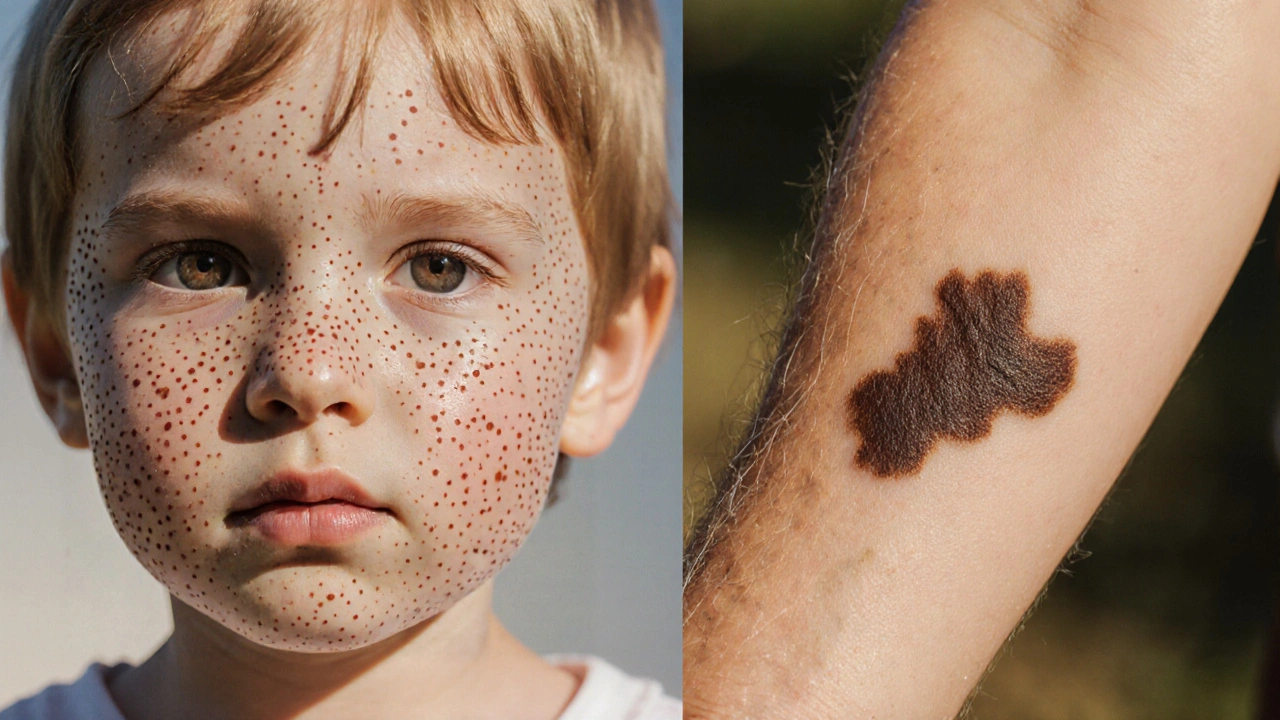
Health October 14, 2025
Freckles vs. Age Spots: Identify, Understand & Treat
Freckles vs. Age Spots Diagnostic Quiz
Answer 5 questions to identify your skin spots
1. How old were you when these spots first appeared?
2. How do the spots change with sun exposure?
3. What's the typical size of your spots?
4. How do the spots appear on your skin?
5. Where are these spots most commonly located?
Your Results
Answer the questions above to see your results
Key Takeaways
- Freckles are small, flat, genetic spots that appear early and stay fairly stable.
- Age spots (also called liver spots) develop later, grow larger, and are triggered by sun exposure.
- Both conditions involve melanin, but the underlying mechanisms differ.
- Simple sun protection can prevent new age spots; genetics mainly dictate freckles.
- If a spot changes in size, shape, or colour, see a dermatologist promptly.
When you glance at your skin, you might notice tiny brown dots or larger, irregular patches. It’s easy to lump them together, but freckles vs age spots are not the same thing, and each tells a different story about your skin’s health.
Freckles are small, flat, brownish spots that result from a concentration of melanin in the skin’s upper layer. They typically appear in childhood, intensify with sun exposure, and are most common on fair‑skinned individuals.
Age spots are larger, darker patches that develop later in life, usually on areas that have had prolonged sun exposure. They are also known as liver spots or solar lentigines.
What Causes Freckles?
Freckles form when melanocytes-cells that produce the pigment melanin-release more melanin in localized areas. The key drivers are:
- Genetics: If your parents have many freckles, you’re likely to inherit the trait.
- UV radiation: Sunlight stimulates melanin production, making freckles darker during summer months.
Freckles are harmless and do not signal disease, but they do indicate a skin type that is more sensitive to UV damage.
What Triggers Age Spots?
Age spots arise from cumulative sun damage over years. Their formation involves:
- UV radiation breaking down skin’s collagen and elastin, prompting melanocytes to cluster and produce excess pigment.
- Hyperpigmentation: The skin’s repair response leaves behind darkened cells that linger as age spots.
- Ageing: As we get older, the skin’s ability to evenly distribute melanin declines, leading to uneven patches.
Unlike freckles, age spots can signal that your skin has suffered significant UV exposure, which raises the long‑term risk of skin cancer.

How to Tell Freckles Apart from Age Spots
Visually, the two look similar, but a few clues help you differentiate them:
| Feature | Freckles | Age Spots |
|---|---|---|
| Typical size | 1-2mm, uniform | 2mm up to several centimeters, irregular |
| Shape | Round, even | Oval, blotchy, sometimes jagged |
| Color | Light to medium brown, may fade in winter | Medium to dark brown, often stays constant |
| Location | Face, arms, shoulders-areas exposed but not heavily sun‑damaged | Forehead, cheeks, hands, back of the arms-areas with chronic sun exposure |
| Age of onset | Childhood, early teens | 30s onward, intensifying with age |
If you’re still unsure, compare a spot’s reaction to the seasonal sun. Freckles usually darken in summer and lighten in winter, while age spots stay relatively unchanged.
When Should You Be Concerned?
Most freckles are benign, but any pigment change warrants a check. Watch for:
- Border irregularity or fuzziness.
- Colour variation (multiple shades within one spot).
- Rapid growth in size.
- Itching, bleeding, or crusting.
These signs could indicate skin cancer, especially melanoma, which often begins as a pigmented lesion. If any of these appear, schedule an appointment with a dermatologist promptly.
Prevention: Sun Protection Strategies
Because UV radiation drives both freckles and age spots, sun protection is the single most effective tool.
- Apply a broad‑spectrum sunscreen (SPF30 or higher) every morning, reapply every two hours outdoors.
- Wear protective clothing: wide‑brimmed hats, long sleeves, UV‑blocking sunglasses.
- Seek shade between 10am and 4pm when UV intensity peaks.
- Use antioxidants (vitaminC, vitaminE) in skincare to neutralise free radicals caused by UV exposure.
For those prone to age spots, consider a sunscreen that also contains zinc oxide or titanium dioxide for physical UV blockade.
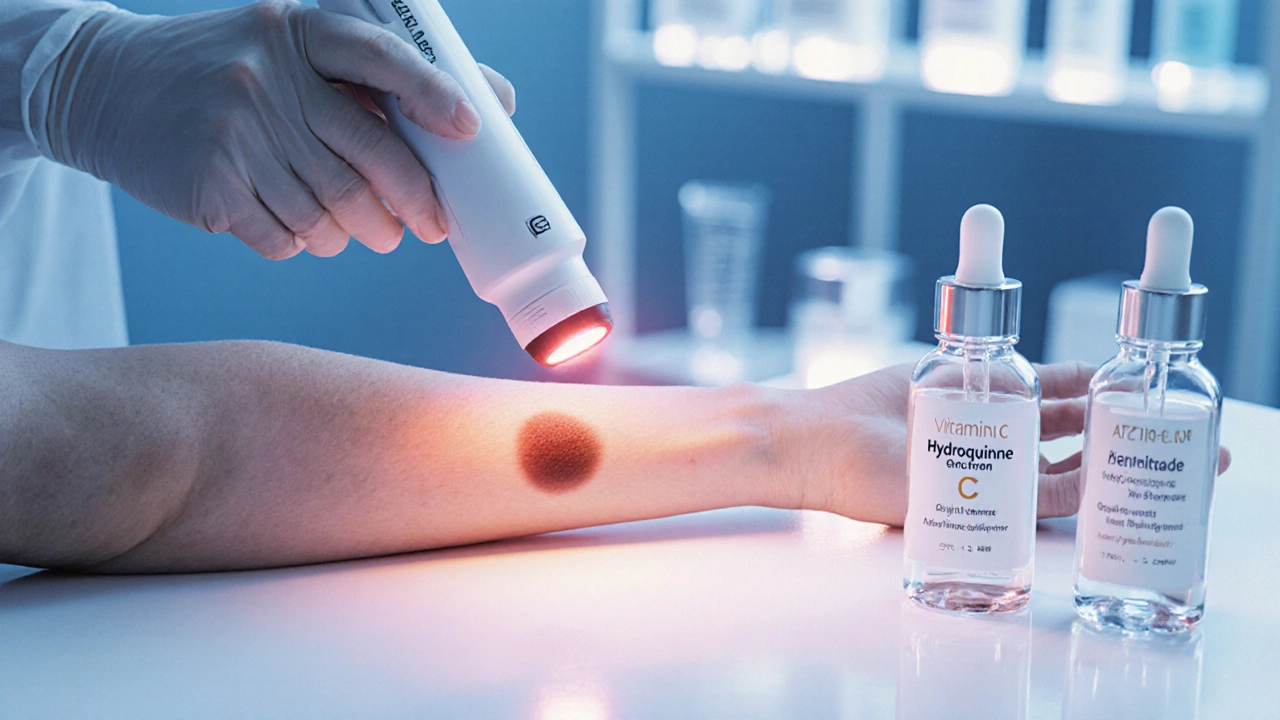
Treatment Options for Existing Spots
While freckles rarely need treatment, many people choose to fade them for aesthetic reasons. Age spots, on the other, often merit active intervention.
- Topical agents: Products with hydroquinone, kojic acid, or azelaic acid can lighten both freckles and age spots over several weeks.
- Retinoids: Prescription‑strength tretinoin accelerates cell turnover, reducing pigment buildup.
- Chemical peels: Glycolic or lactic acid peels exfoliate the top skin layer, revealing smoother, less pigmented skin.
- Laser therapy: Q‑switched lasers target melanin directly, offering quicker results for stubborn age spots.
- Cryotherapy: Freezing the spot with liquid nitrogen can disrupt melanin clusters-primarily used for isolated age spots.
Always discuss with a dermatologist before starting a regimen, especially if you have sensitive skin or a history of reactions.
Choosing the Right Skincare Routine
Here’s a simple daily routine that addresses both freckles and age spots while protecting against future damage:
- Cleanse with a gentle, pH‑balanced cleanser.
- Treat with a serum containing vitaminC (antioxidant) and niacinamide (brightening).
- Moisturise using a cream with hyaluronic acid and a modest amount of niacinamide.
- Protect by applying broad‑spectrum SPF30+ sunscreen. If you have noticeable age spots, choose a formula with added zinc oxide.
For targeted fading, add a night‑time product with 2‑5% hydroquinone or a prescription retinoid as advised by your dermatologist.
Frequently Asked Questions
Can freckles turn into age spots?
No. Freckles and age spots have different origins. Freckles are genetically driven and stable, while age spots result from cumulative sun damage over years.
Are age spots a sign of skin cancer?
Age spots themselves are benign, but any sudden change in a pigmented lesion-such as uneven borders, new colour variations, or rapid growth-should be evaluated by a dermatologist to rule out melanoma.
Will sunscreen erase existing freckles?
Sunscreen prevents new pigment formation and can gradually lighten existing freckles over months, but it won’t erase them instantly. For faster results, combine sunscreen with a brightening serum.
Is it safe to use over‑the‑counter bleaching creams?
Most OTC creams contain low concentrations of hydroquinone or kojic acid and are safe for short‑term use. However, higher‑strength products need a prescription to avoid irritation or ochronosis.
How often should I see a dermatologist for pigment concerns?
If you notice any of the warning signs listed earlier, schedule an appointment immediately. Otherwise, an annual skin‑check is a good routine, especially after prolonged sun exposure seasons.
Understanding the distinction between freckles and age spots empowers you to protect your skin, choose the right treatments, and catch any serious issues early. Keep an eye on changes, stay sun‑smart, and enjoy healthier, more even‑toned skin.
Write a comment
Items marked with * are required.
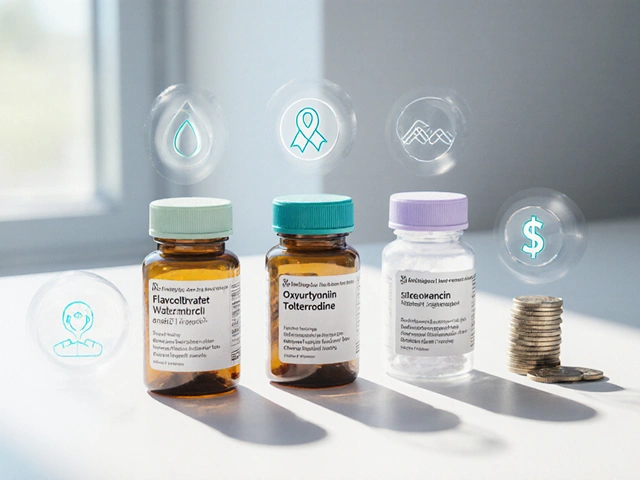

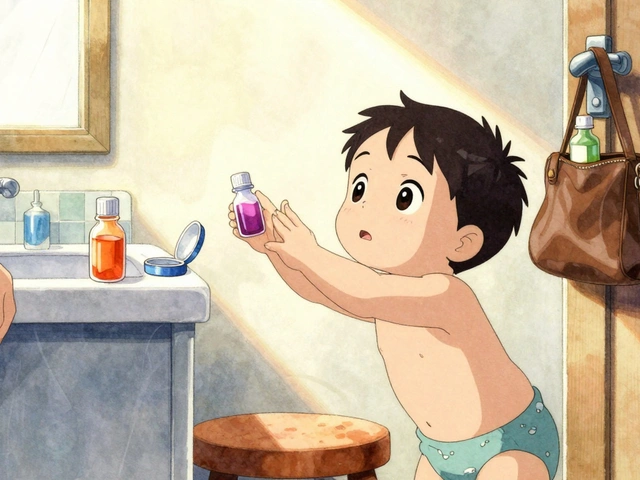
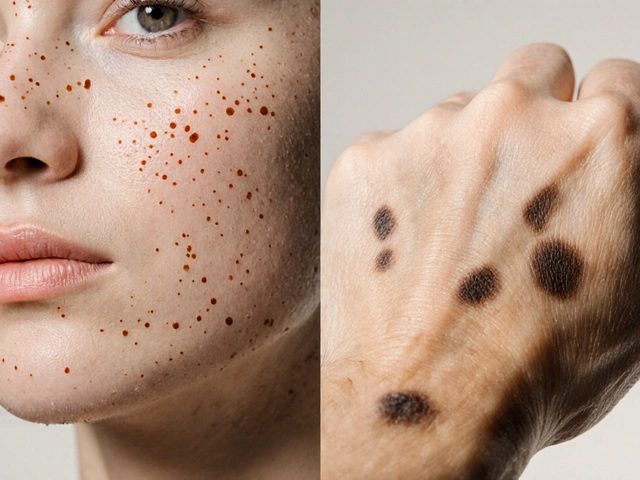
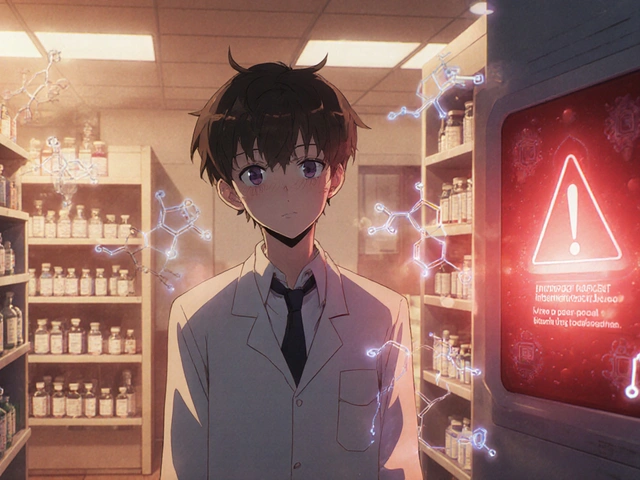

15 Comments
John Villamayor October 15, 2025 AT 21:16
I used to think freckles were just sun damage but now I get it-they're like your genes saying hi. Age spots? That's your skin screaming for sunscreen. I've been slathering SPF 50 every morning since I turned 30. No regrets.
Jenna Hobbs October 16, 2025 AT 02:24
OMG YES!! I had this one spot on my hand that looked like a coffee stain-turned out to be an age spot 😱 I started wearing gloves gardening and now it’s fading!! Sunscreen is non-negotiable. Also, vitamin C serum changed my life. 🌞✨
Ophelia Q October 16, 2025 AT 07:45
I'm 28 and already have both. Freckles since I was 8, age spots popping up since last summer. I didn't realize how much damage the sun did until I started using zinc oxide. It's not sexy but it works. Also, if you're gonna use hydroquinone, do it under a derm's watch. Don't be like me and burn your face trying to go quick.
Elliott Jackson October 18, 2025 AT 07:21
You people are overcomplicating this. Freckles = genetic luck. Age spots = you didn't wear sunscreen as a teen. End of story. Also, laser treatments are a scam unless you're rich. I just use niacinamide and call it a day.
McKayla Carda October 18, 2025 AT 12:48
I used to ignore my freckles until I got an age spot on my nose. Now I wear sunscreen daily. Simple. Effective. No drama.
Christopher Ramsbottom-Isherwood October 19, 2025 AT 06:31
Actually, the article oversimplifies. Melanin clustering isn't just about UV-it's also about inflammation, oxidative stress, even hormonal shifts. And calling them 'liver spots' is outdated terminology. That term was debunked in the 80s. But sure, keep calling them that.
Stacy Reed October 20, 2025 AT 09:46
I wonder if these spots are just our skin's way of telling us we're not living authentically. Like, maybe the freckles are our childhood joy, and the age spots are the weight of unprocessed trauma. Have you ever sat with your skin and asked it what it needs? I tried. It cried. I cried too.
Robert Gallagher October 21, 2025 AT 15:06
I started using sunscreen at 45. Took me 20 years to get here. Now I have this glow. Not from the sun-from the zinc oxide. Also, I got a chemical peel last month. Best $400 I ever spent. My skin looks like a newborn's. Or at least like a 25-year-old's who never touched a tanning bed.
Howard Lee October 22, 2025 AT 06:34
The article correctly identifies the distinction between freckles and solar lentigines. However, it should note that topical retinoids require a minimum of 12 weeks of consistent use to demonstrate statistically significant pigment reduction. Also, hydroquinone concentrations above 2% are regulated in the EU. Always verify product labeling.
Nicole Carpentier October 23, 2025 AT 18:37
I used to hate my freckles. Now I think they’re cute. But the age spots? Nope. Not happening. I’ve got a whole routine: cleanse, vitamin C, moisturize, SPF 50. No exceptions. Even on cloudy days. My skin is my only real estate. I protect it like a bank vault.
Hadrian D'Souza October 25, 2025 AT 10:18
Wow. Another wellness influencer guide. Let me guess-you're selling a $120 serum that's just vitamin C and water? And you call that science? I've got a 50-year-old aunt who swears by lemon juice and honey. It's cheaper, it's natural, and it doesn't come with a cult following. Also, sunscreen is for people who don't know how to tan properly.
Brandon Benzi October 27, 2025 AT 00:58
This is why America is falling apart. We're too scared to get a tan. Back in my day, we didn't wear SPF. We got freckles, we got spots, we got older. Now everyone's scared of the sun like it's a villain. Get a grip. Skin cancer? It's rare. But your fear? That's epidemic.
Abhay Chitnis October 27, 2025 AT 19:23
In India we don't care about freckles. We use turmeric paste, neem, and aloe vera. No chemicals. No lasers. Just nature. And guess what? We don't have age spots like you. Maybe you should try real medicine, not fancy creams from the US.
Robert Spiece October 28, 2025 AT 18:36
Let’s be honest-this whole thing is capitalism dressed up as dermatology. You’re not treating age spots. You’re treating the fear of aging. The real issue isn’t melanin. It’s the cultural obsession with flawless skin. We’ve turned skin into a performance. And we’re all exhausted from trying to look like we never existed.
Vivian Quinones October 28, 2025 AT 18:47
I just use coconut oil and call it a day. My grandma did it. I do it. No fancy stuff. Sunscreen? Meh. I like the sun. Let my skin do what it wants. If it gets spots, fine. It’s part of life. You all are too obsessed with looking young. Grow old with pride.